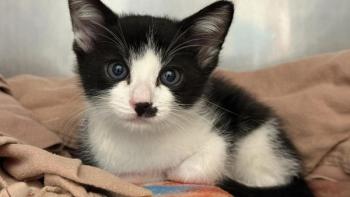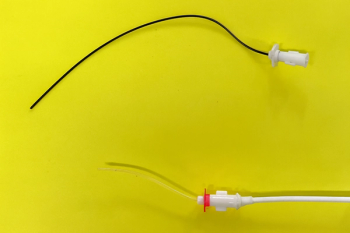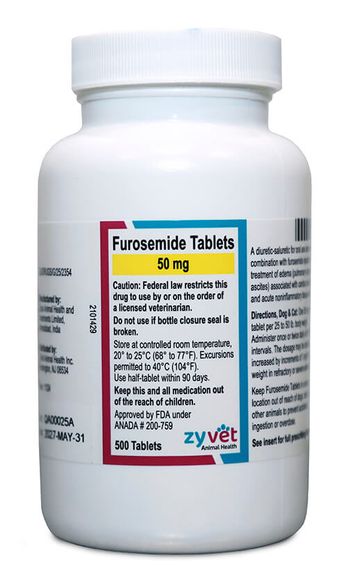
Pandora syndrome: Rethinking our approach to idiopathic cystitis in cats
Look outside the urinary tract-as well as in the cat's environment-for diagnostic and therapeutic answers.
The variety of comorbidities—epithelial, neurologic, endocrine, immune, and behavioral disorders—you may encounter as you start to evaluate cats with lower urinary tract signs equate with the troubles that escape Pandora's box. But, as with the myth, hope remains. We've only to explore Pandora syndrome more and seek out treatments such as environmental enrichment to continue to help our patients and their owners.
Getty Images
Keeping cats indoors has become common veterinary advice to reduce the risk of exposure to infectious diseases and injury from vehicles or other animals. This advice may not be completely beneficial or even benign for cats, however. As early as 1925, "too close confinement to the house" was suggested to increase the risk of lower urinary tract signs (LUTS).1
Many factors associated with indoor housing and LUTS have been investigated. Excessive body weight and decreased activity were associated with increased risk in some studies, and cats that only had access to indoor litter pans had an increased risk of LUTS compared with cats that could eliminate outdoors.2 Living with other cats has also been associated with LUTS, suggesting that social interactions or a horizontally transmitted infectious agent might play a role in the development of these signs.2,3 The lack of difference between cases and controls in viral disease rates and the increase in risk associated with the amount of time spent indoors seem to argue against an infectious agent as a common cause.
In addition to the factors listed above, one case-control study of cats with LUTS reported an increased incidence of LUTS in cats that moved into a new house within the previous three months and during winter months2 ; further analysis revealed a highly statistically significant association with rainy days during the previous month rather than with the season. Access to outdoor prey was found to be protective.
In addition to LUTS, studies have found indoor housing to be associated with a variety of other common diseases in cats.3 For example, dental disease is reported to be the most common disease in pet cats. Although indoor housing was not identified as a significant risk factor in one study, in a subsequent study, indoor housing was associated with a 4.5-fold increase in risk for gingivitis, calculus, or periodontal disease. Obesity in cats is also a common problem, and apartment dwelling, inactivity, certain dietary factors, and being middle-aged, male, neutered, and of mixed breeding have been associated with being overweight. Indoor housing has been associated with a 1.6- to 15.8-fold risk for obesity, depending on the parameter measured.3 One recent study reported that indoor confinement and physical inactivity—but not the proportion of dry food fed—were associated with increased risk for type 2 diabetes.4
These and other studies conducted over decades and around the world have identified indoor housing as a risk factor for disease in cats. Differences among studies, particularly those that did not find increased risk, might have occurred for a variety of reasons. The first, of course, being that indoor housing is not a risk factor. However, the fact that indoor housing has been associated with a variety of different diseases studied at different times and in different places seems to argue against this interpretation. Differences in sample sizes and the questions asked, undoubtedly, also contributed to the differences. Because the cats in most recent studies were all housed inside, nothing can be gleaned regarding the contributing factor of indoor housing. The identification of differences in breed susceptibilities also suggests that internal factors, including genetic (which genes are present) and epigenetic (which of the genes present that are expressed) factors, also influence risk.
SPECIES SUSCEPTIBILITY
The sensitivity of cats to their surroundings and their responses to threatening stimuli have been studied for decades. The term fight-or-flight response resulted from studies of cats conducted during the first two decades of the 20th century by the eminent physiologist Walter B. Cannon.5 Cats are a relatively solitary species,6 often choosing population densities of fewer than 50 cats per square kilometer. Although free-ranging male and female cats occupy overlapping home ranges of about 100 meters in diameter, they often avoid meeting each other by keeping to a schedule. In a study of households with two cats, about 50% of time was spent out of one another's sight, even though they were often within 1 to 3 meters of each other.7 Thus, cats may be unusually susceptible to indoor restriction because of the differences between their behavioral strategies and those of other social species, including most other domestic animals, and people.
PATHOPHYSIOLOGY OF CATS WITH LUTS AND ASSOCIATED PROBLEMS
Based on a series of studies conducted during the past two decades, various conditions and diseases beyond the urinary tract have been identified in cats with severe, recurrent LUTS.8 Understanding the underlying processes that lead to these abnormalities may be the key in diagnosing and treating affected cats. It is thought that some cats, because of a combination of genetics and early environment, have a more sensitive and overactive sympathetic nervous system,9 and this is thought to be associated with abnormalities in intestinal, behavioral, dermatologic, epithelial, neurologic, endocrine, or immune systems. These comorbidities can occur in any combination, and some of them may precede the development of LUTS. These conditions, as well as environmental stressors, can manifest as what we call sickness behaviors.10
Sickness behaviors refer to a group of nonspecific behavioral and clinical signs including vomiting, diarrhea, anorexia or decreased food and water intake, fever, lethargy, somnolence, enhanced painlike behaviors, and decreased general activity, body-care activities (grooming), and social interactions. Although these behaviors are well-documented responses to infection, they also occur in response to aversive environmental events. Thus, sickness behaviors can result both from peripheral (i.e. afferent) and central (i.e. efferent) pathways.10
The repeated observation that most of these associated problems and sickness behaviors resolve after exposure to an enriched environment provides additional evidence of a central nervous system disorder resulting in a chronic multisystem illness variably affecting the bladder and other organs, as opposed to a peripheral organ-based problem.10-12
DIAGNOSING PANDORA SYNDROME
Because of the evidence outlined above, I think that some cats with chronic LUTS may have a Pandora syndrome, named for the Pandora myth (see
Based on the available evidence, provisional criteria for a diagnosis of Pandora syndrome might include
- Chronicity: Persistence or recurrence of the condition over months to years
- Comorbidity: Evidence of problems in other body systems (e.g. behavior, endocrine, gastrointestinal, respiratory, or dermatologic problems), particularly preceding the presenting LUTS
- Patient history: A history of early adverse experience (orphaned, bottle fed, rescued)
- Genetics: Evidence of familial involvement (parents or littermates have a similar illness profile).
Owners often do not have information about their cats' early experience and family members, and none of these criteria can be considered pathognomonic for anything. They may serve only to raise an index of suspicion that a more systemic problem may be present.
Before assuming that a cat has an isolated bladder (or other) disease, take the time to obtain a comprehensive review of the cat's history and conduct a thorough physical examination. You may find that some cats have a disease affecting more than just the organ attributed to the presenting signs, which can helpfully guide your diagnostic and therapeutic recommendations.
ENVIRONMENTAL ENRICHMENT
Environmental enrichment is the first line of therapy to reduce the risk of recurrence of whatever clinical signs are present.10-12 Environmental enrichment for indoor-housed cats means providing all necessary resources, refining interactions with owners, achieving a tolerable intensity of conflict, and thoughtfully instituting changes.13,14 The broad categories of food, water, litter boxes, space, play, conflict management, and pheromones should all be considered based on their influence on the health and welfare of indoor-housed cats.
Have clients fill out the household resources survey (
Household Resources Survey
Because of the dearth of controlled trials, it is not possible to prioritize the importance of any of these suggestions or to predict which would be the most appropriate in a particular situation. Appropriately designed epidemiologic studies might be able to identify particularly important factors, after which intervention trials could be conducted to determine their efficacy in circumstances in which owners successfully implemented the suggested changes.
Food
Cats prefer to eat individually in quiet locations where they will not be threatened or startled by other animals, sudden movement, or an air duct or appliance that may begin operation unexpectedly while the cat is eating. Although canned food may be preferable for some cats because of the increased water content or a more natural mouth feel, some cats prefer dry foods. If a diet change is appropriate, offering the new diet in a separate, adjacent container rather than removing the usual food and replacing it with the new food permits the cat to express its preference. Specific ingredients or nutrients in food have been found to be of minor significance to patient outcome when an enriched environment is provided.10-12
Natural cat feeding behavior also includes predatory activities, such as stalking and pouncing. If a cat is interested, an owner can simulate these feeding situations by hiding small amounts of food around the house or putting dry food into a container from which the cat has to extract individual pieces or move to release the food pieces. Some cats have specific prey preferences. For example, some cats prefer to catch birds, while others may prefer to chase mice or bugs. Identifying a cat's prey preference allows the owner to buy or make toys that the cat will be more likely to play with.
Water
Cats also seem to have preferences regarding drinking water. Water-related factors to consider include the freshness, taste, movement (water fountains, dripping faucets, aquarium pump-bubbled air into a bowl), and shape of the container (some cats resent having their vibrissae touch the sides of a container when drinking). As with diet, changes in water-related factors should be offered in such a way that permits the cat to express its preference. Additionally, food and water bowls should be cleaned regularly unless individual preference suggests otherwise.
Litter boxes
Litter boxes should be provided in several locations throughout the house, particularly in multicat households. Placing litter boxes in quiet, convenient locations that provide an escape route for a cat if necessary may help improve conditions and encourage normal elimination behaviors. Since individual preferences for litter type have been documented, if different litters are offered, it is preferable to test the cat's preference by providing them in separate boxes. For cats with a history of urinary problems, unscented clumping litter should be considered. Litter boxes should be cleaned regularly and replaced; some cats are sensitive to dirty litter boxes. Litter box size and whether it is open or covered may also be important to some cats.15
Space
Cats interact with both physical structures and other animals, including people, in their environment. The physical environment should include opportunities for scratching (both horizontal and vertical), climbing, hiding, and resting. Many cats prefer to monitor their surroundings from elevated vantage points, so climbing frames, hammocks, platforms, raised walkways, shelves, or window seats may appeal to them. Playing a radio to habituate cats to sudden changes in sound and human voices also may be useful, and videotapes to provide visual stimulation are available.
Play
Some cats prefer to be petted and groomed, whereas others may prefer play interactions with owners. Cats also can be easily trained to perform behaviors (tricks); owners just need to understand that cats respond better to praise than to force and are more amenable to learning when the behavior is shaped before feeding. Cats may also enjoy playing with toys, particularly those that are small, move, and mimic prey characteristics. Many cats also prefer novelty, so a variety of toys should be provided and rotated or replaced regularly to sustain their interest.
Conflict management
When a cat's perception of safety becomes threatened, it responds by attempting to restore its perception of control.16 During such responses, some cats become aggressive, withdrawn, or ill.10 In my experience, intercat conflict commonly is present when multiple cats are housed indoors together and health problems are encountered.
Signs of trouble. Signs of conflict between cats can be open or silent. Cats in open conflict may stalk each other, hiss, and turn sideways with legs straight and hair standing on end to make themselves look larger. In contrast, signs of silent conflict can be easily missed: Threatened cats may avoid other cats, decrease their activity, or both. They often spend increasingly large amounts of time away from the family, stay in areas other cats do not use, or attempt to interact with family members only when the assertive cat is elsewhere.
Signs can result from two types of conflict: offensive and defensive. In offensive conflict situations, the assertive cat moves closer to the other cats to control the interaction. In defensive conflict situations, the threatened cat attempts to increase the distance between itself and the perceived threat. Although cats engaged in either type of conflict may spray or eliminate outside the litter box, I find that threatened cats are more likely to develop elimination problems.
Causes of conflict. A common cause of conflict between indoor-housed cats is competition for resources (e.g. space, food, water, litter boxes, perches, sunny areas, safe places where the cat can watch its environment, or attention from people). Conflict may develop even if no limitation to access to these resources is apparent to the owner. The cat's perception of how much control it wants over the environment or its housemates' behaviors determines the result.
Open conflict is most likely to occur when a new cat is introduced into the house or when cats that have known each other since kittenhood reach social maturity. Conflict occurring when a new cat is introduced is easy to understand, and good directions are available for introducing a new cat to the residents.17 However, clients may be puzzled by conflict that starts when one of their cats becomes socially mature or when a socially mature cat perceives that one of its housemates is becoming socially mature. When cats become socially mature, they may start to exert control over the social groups and their activities, which may lead to open conflict between male cats, between female cats, or between male and female cats. Although the cats involved in the conflict may never be best friends, they usually can live together without showing signs of conflict or conflict-related illness. In severe cases, a behaviorist can be consulted for assistance in desensitizing and counterconditioning the cats in conflict so they can share the same spaces more comfortably.
Treatment interventions. Treatment for conflict between cats involves providing a separate set of resources for each cat, preferably in locations where the cats can use them without being seen by other cats. That lets the cats avoid each other if they choose to without being deprived of any essential resource. Cats may require more space than the average house or apartment affords them. The addition of elevated spaces such as shelves, kitty condos, cardboard boxes, beds, or crates may provide enough three-dimensional space to reduce conflict to a tolerable level.
In severe situations, some cats may benefit from behavior-modifying medications. In my experience, medication can help when combined with environmental enrichment, but cannot replace it. Conflict also can be reduced by neutering all cats and by keeping all nails trimmed as short as practical. Whenever the cats involved in the conflict cannot be directly supervised, they may need to be separated. For example, the threatened cat could be provided with a refuge away from the other cats. This space should contain all necessary resources for the cat staying in it.
Conflict with other animals, dogs, children, or adults is relatively straightforward. In addition to being solitary hunters of small prey, cats are small prey themselves for other carnivores, including dogs. Regardless of how sure clients are that their dogs will not hurt their cats, to the cat, the dog may represent a predator. To ensure a cat's safety, it must be provided with avenues of escape that can be used at any time. For owners, it usually suffices to explain that cats may not understand rough treatment as play, but may perceive it as a predatory threat.
Most cats in urban areas in the United States are housed indoors and neutered, so conflict with outside cats occurs when a new cat enters the area around the house the affected cat lives in. To cats, windows offer no protection from a threatening cat outside. If outside cats are the source of the problem, a variety of strategies to make one's garden or yard less desirable to them are available.
Pheromones
A novel aspect of environmental enrichment that has become available is the application of pheromones to the living space. Pheromones are chemical substances that transmit highly specific information between animals of the same species. Although the exact mechanism of action is unknown, pheromones appear to effect changes in the function of both the limbic system and the hypothalamus to alter the emotional status of the animals.
Feliway (Ceva Animal Health), a synthetic analogue of naturally occurring feline facial pheromone and valerian, was developed to decrease anxiety-related behaviors in cats. Use of this product has been reported to reduce the amount of anxiety experienced by cats in unfamiliar circumstances, a response that may be helpful to these patients and their owners. Decreased spraying in multicat households, decreased marking, and a significant decrease in scratching behavior have also been reported subsequent to its use.18 Pheromones are not a panacea for unwanted cat behaviors, however, and were found to be no better than placebo in one study.19 Their effectiveness may be improved by combining them with environmental enrichment or drug therapies, but, to date, the clinical effectiveness of these combinations has not been thoroughly investigated.
Follow-up
One of the critical keys to any successful therapy program is to follow the patient's progress. I tell clients what our follow-up schedule is and ask them to agree to a preferred method and time to be contacted. Our first contact with the client occurs by telephone within a week after initial recommendations are made, followed by repeat check-ins at three to six weeks, three months, six months, and a year in uncomplicated cases that need less follow-up. (Referral may be necessary for more complicated cases.) This schedule allows technicians (under veterinary supervision) to monitor the patient's progress, make adjustments as needed, and continue to support and motivate the client. It also helps us determine when an owner is becoming frustrated or is having problems with the plan, and we can then offer encouragement or suggestions.
Technicians are an important part of the team in the process of empowering clients to make changes and implement new enrichment strategies deemed likely to be most helpful if they are provided enough support and guidance. Veterinarians alone may not be able to cost effectively provide the time and energy for these efforts on their own, but may be able to provide effective training and supervision of motivated technicians.
CONCLUSIONS
Many indoor-housed cats appear to survive perfectly well by accommodating to less than perfect surroundings. However, the neuroendocrine-immune abnormalities of some cats do not seem to permit the adaptive capacity to stress that healthy cats enjoy, so these cats may be considered a separate population with greater needs, as they have a greater risk of developing disease in response to stress. (See
Finally, the question of the relative merits of indoor housing to promote the welfare of cats—and the different opinions on what constitutes animal welfare in general—is beyond the scope of this article and is a subject of controversy among experts. I hope to encourage extension of the welfare efforts of individuals working in zoos—who have recognized the effects of housing quality on the health of animals in their care and have worked to enrich the environments of these animals—to all captive animals in our care. I think that idiopathic cystitis and a variety of related disorders are better prevented than treated and that we have a great opportunity to encourage this husbandry approach in veterinary clinical practice. Further information about environmental enrichment for indoor-housed cats is available at
C.A. Tony Buffington, DVM, PhD, DACVN
Department of Veterinary Clinical Sciences
College of Veterinary Medicine
The Ohio State University
Columbus, OH 43210
REFERENCES
1. Kirk H. Retention of urine and urine deposits. In: The diseases of the cat and its general management. London: Bailliere, Tindall and Cox, 1925;261-267.
2. Jones BR, Sanson RL, Morris RS. Elucidating the risk factors of feline lower urinary tract disease. N Z Vet J 1997;45:100-108.
3. Buffington CA. External and internal influences on disease risk in cats. J Am Vet Med Assoc 2002;220:994-1002.
4. Slingerland LI, Fazilova VV, Plantinga EA, et al. Indoor confinement and physical inactivity rather than the proportion of dry food are risk factors in the development of feline type 2 diabetes mellitus. Vet J 2009;179:247-253.
5. Cannon WB. The mechanism of emotional disturbance of bodily functions. N Engl J Med 1928;198:877-884.
6. Gittleman JL. Carnivore group living: comparative trends. In: Carnivore behavior, ecology, and evolution. Ithaca, N.Y.: Cornell University Press, 1989;183-207.
7. Barry KJ, Crowell-Davis SL. Gender differences in the social behavior of the neutered indoor-only domestic cat. Appl Anim Behav Sci 1999;64:193-211.
8. Buffington CA. Idiopathic cystitis in domestic cats—beyond the lower urinary tract. J Vet Intern Med 2011;25:784-796.
9. Buffington CA. Developmental influences on medically unexplained symptoms. Psychother Psychosom 2009;78:139-144.
10. Stella JL, Lord LK, Buffington CA. Sickness behaviors in response to unusual external events in healthy cats and cats with feline interstitial cystitis. J Am Vet Med Assoc 2011;238:67-73.
11. Westropp JL, Kass PH, Buffington CA. Evaluation of the effects of stress in cats with idiopathic cystitis. Am J Vet Res 2006;67:731-736.
12. Buffington CA, Westropp JL, Chew DJ, et al. Clinical evaluation of multimodal environmental modification (MEMO) in the management of cats with idiopathic cystitis. J Feline Med Surg 2006;8:261-268.
13. Westropp JL, Buffington CA. Lower urinary tract disorders in cats. In: Ettinger SJ, Feldman EC, eds. Textbook of veterinary internal medicine. 7th ed. St. Louis, Mo: Elsevier-Saunders, 2010;2069-2086.
14. Herron ME, Buffington CA. Environmental enrichment for indoor cats. Compend Contin Educ Pract Vet 2010;32:E1-E5.
15. Herron ME. Advances in understanding and treatment of feline inappropriate elimination. Top Companion Anim Med 2010;25:195-202.
16. Moesta A, Crowell-Davis S. Intercat aggression—general considerations, prevention and treatment. Tierarztliche Praxis Kleintiere 2011;39:97-104.
17. Overall KL, Rodan I, Beaver BV, et al. Feline behavior guidelines from the American Association of Feline Practitioners. J Am Vet Med Assoc 2005;227:70-84.
18. Pageat P, Gaultier E. Current research in canine and feline pheromones. Vet Clin North Am Small Anim Pract 2003;33:187-211.
19. Gunn-Moore DA, Cameron ME. A pilot study using synthetic feline facial pheromone for the management of feline idiopathic cystitis. J Feline Med Surg 2004;6:133-138.
Newsletter
From exam room tips to practice management insights, get trusted veterinary news delivered straight to your inbox—subscribe to dvm360.






